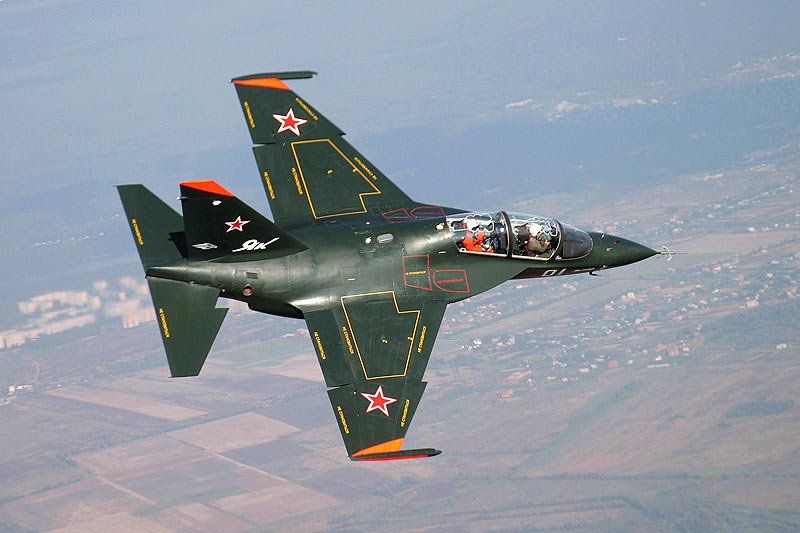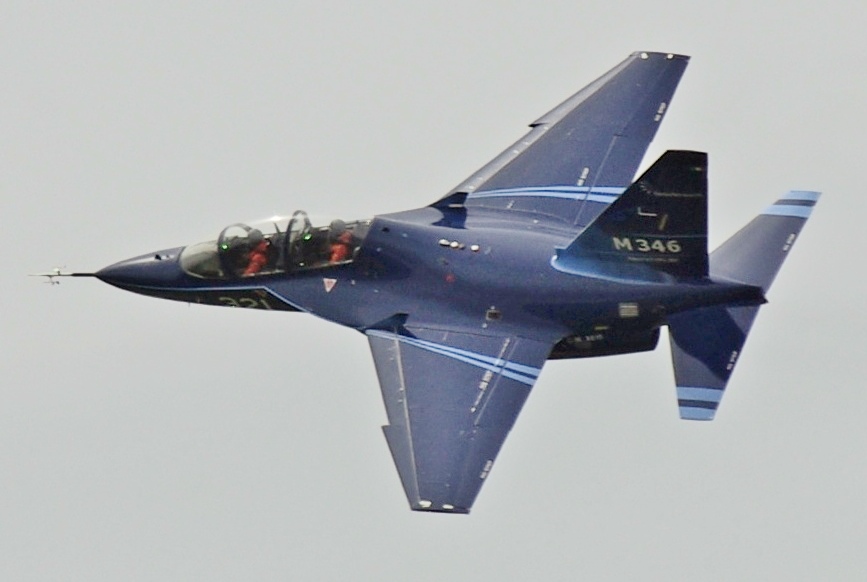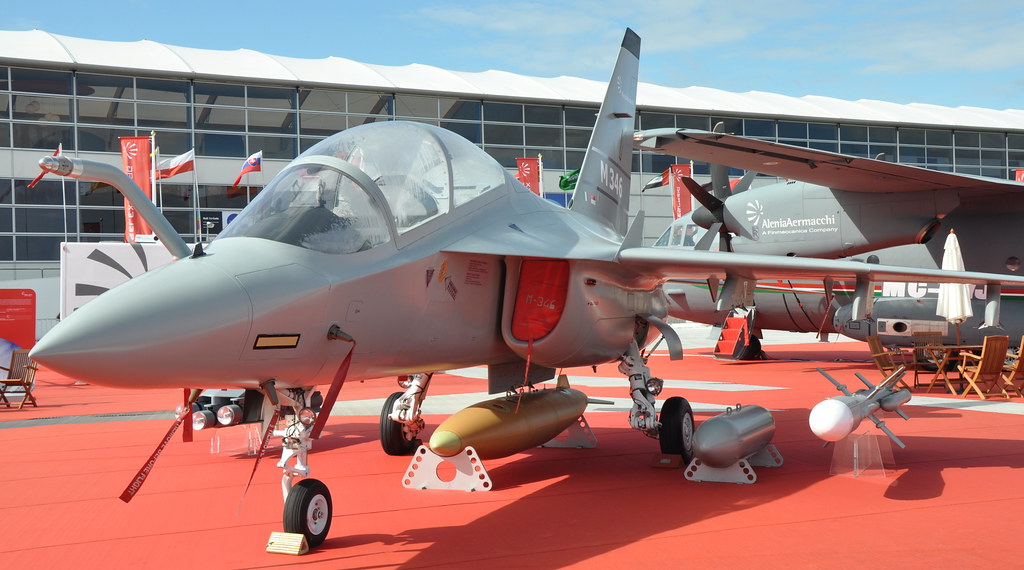The Alenia Aermacchi M-346 Master is a military transonic trainer aircraft. The aircraft is a development of the YAK/AEM-130, a joint programme with Yakolev Design Bureau and Sokol Manufacturing Plant of Russia. In July 2000, Alenia Aermacchi announced that it would cancel the joint project and develop the aircraft alone, as the M-346.
The M-346 provides combat pilot training for front line fighters with high angle-of-attack capability. The aerodynamic design of the M-346 uses vortex lift to provide manoeuvrability and controllability at very high angle-of-attack using a fly-by-wire control system.
The YAK/AEM-130 has flown in prototype form since 1996. As the Yak-130, the aircraft was selected in March 2002 as the Russian AF's next generation combat trainer.
Development
In 1993, Aermacchi signed an agreement to partner with Yakovlev on the new trainer the firm had been developing since 1991 for the Russian Air Force. The resulting aircraft first flew in 1996 and was brought to Italy the following year to replace the aging MB-339. At the time, the aircraft was marketed as the Yak/AEM-130, however, by 2000, differences in priorities between the two firms had brought about an end to the partnership, with each developing the aircraft independently; Yakovlev received US$77 million for technical documents of the aircraft.Yakovlev would be able to sell the aircraft to countries such those in the Commonwealth of Independent States, India, Slovakia and Algeria. Aeromacchi would be able to sell to NATO countries, among others.A Russian version is also being pursued by Yakovlev and Sokol, under a different time schedule.
The M-346 is a highly modified version of the aircraft the joint venture produced, and uses equipment exclusively from Western manufacturers. The first prototype rolled out on 7 June 2003 and flew for the first time on 15 July 2004.
In January 2005, the Greek Ministry of Defence signed a Memorandum of Understanding (MOU) to become a partner in the programme and, in 2006, Aermacchi signed an industrial cooperation agreement with Hellenic Aerospace Industry.
In July 2007, the M-346 flew to the United Arab Emirates for hot weather tests and operational evaluation by the UAE Air Force.
In March 2008 the Chilean ENAER signed a Memorandum of Understanding (MOU) with Alenia Aermacchi at the FIDAE air show.
On 10 April 2008 one further prototype in the final configuration (new landing gear and air brake, more composite parts) was rolled out: first flight of this "Industrial Baseline Configuration" was expected in June.On 18 December 2008, the M-346 reached a maximum speed of Mach 1.15 (1,255 km/h, 678 knots, 780 mph).
In May 2008 Boeing signed a Memorandum of Understanding to cooperate on the marketing, sales, training and support of two Aermacchi trainers, the M-346 and the M-311.
The development of a full-mission simulator for the M-346 has been awarded to CAE and is under development.
The cockpit is representative of the latest-generation combat aircraft, and each crew position is equipped with raster / stroke type head-up display (HUD), full-colour liquid crystal multifunction displays (three in each cockpit), helmet-mounted display with threat simulation capability, night-vision goggle (NVG) compatible instrumentation and hands-on throttle and stick (HOTAS) controls.
The cockpits can be fitted with MK16 ejection seats from Martin Baker of Uxbridge, UK.
Avionics
The avionics architecture is based on a dual-redundant MIL-STD-1553B digital data bus which has capacity for additional systems. The communication suite includes a VHF/UHF transceiver and an information friend of foe (IFF) transponder. The navigation suite includes a laser gyro inertial navigation system with an embedded GPS receiver, and a tactical air navigation (TACAN) and VHF omnidirectional radio ranging (VOR/IIS/MB).
The flight control system (FCS) is a full authority digital fly-by-wire quadruple-redundant system, which includes four BAE Systems Italia flight control computers.
The FCS provides the aircraft with controllability up to angles of attack (AoA) of 35° and higher, g-limitation, stall and spin prevention, and maximum Angle of Attack (AoA) limitation.
It can be adapted to various degrees of automation and autopilot modes with reversionary modes featuring automatic selection for use in case of damage or failures.
Weapons
Armaments are carried on nine external store stations, six of which are underwing, equipped with 1,000lb class ejector release units, and two wingtip stations for air-to-air missiles. The under-fuselage station carries avionics pods or a 300l conformal fuel tank.
The system data presentation and control functions of the stores management system use any one of the multifunction displays in both cockpits. Hands-on throttle and stick (HOTAS) controls are used to select the weapons. Weapon aiming is controlled by the central main processor, aiming data being presented to the pilots through the head-up display (HUD) or the helmet-mounted display (HMD).
The weapons carried include: MK82 500lb and MK83 1,000lb free fall or retarded bombs; rocket launchers; AIM-9 Sidewinder short-range air-to-air missiles; Raytheon AGM-65 Maverick air-to-ground missiles; MBDA (formerly Alenia) Marte MK-2A anti-ship missiles.
The external hard points can also carry the Vinten VICON-601 reconnaissance pod, laser designator pod, radar warning receiver pod and Elettronica ELT-55 electronic countermeasures pod.
For fighter trainer role, self-protection system functions and simulated tactical scenario threats are presented and monitored on the multifunction displays.
For operational roles, the aircraft is fitted with a radar warning receiver, chaff and flares dispensers, and active electronic countermeasures.
Turbofan engines
Povazke Strojarne L.M. was to be the supplier of the two DV-2S twin-shaft turbofan engines for the YAK/AEM-130. For the M-346, these are replaced with two Honeywell / ITEC F124-GA-200 turbofan engines, produced with Fiat Avio.
There is also a closed-circuit self-contained aerobatics lubrication system and dual channel Full Authority Digital Engine Control (FADEC).
Performance
The M-346 can climb at the rate of 127m/s. The maximum and cruise speed of the aircraft are 1,092km/h and 1,059km/h respectively. Its stall speed is 166km/h. The range and service ceiling of the M-346 are 2,590km and 13,700m respectively. Its take-off run is 320m, while the landing run is 470m. The aircraft weighs around 4,610kg and its maximum take-off weight is 9,000kg.
Operational history
An M-346 at "Giornata Azzurra" 2006 at Pratica di Mare AFB, Italy
The Italian Air Force intends to acquire a first batch of 15 low rate production M-346 aircraft.[8] On 18 June 2009, Alenia Aermacchi announced they had received an order for the first six with an option for nine more.
The M-346 was named the winner of a competition by the United Arab Emirates at the IDEX 2009 defense show in Abu Dhabi on 25 February 2009.[10] The official said the order involved delivery of 48 aircraft to be used for pilot training and light attack duties. A final request for proposals in 2010 had set the requirement at 20 trainers, 20 aircraft for combat duties, and the remainder would go toward the creation of a formation flying team. However, on 27 January 2010, negotiations to sign a contract have reportedly stalled over specifications.
In July 2010, the M-346 was selected by Republic of Singapore Air Force (RSAF) to replace the ST Aerospace A-4SU Super Skyhawks in the Advanced Jet Training (AJT) role, currently based at BA 120 Cazaux Air Base in France.And in a press release by the Singaporean Ministry of Defence on 28 September 2010, ST Aerospace had been awarded the contract to acquire twelve M-346 and a ground based training system on behalf of RSAF. As stipulated in the contract, ST Aerospace will act as the main contractor to maintain the aircraft after delivery by Alenia Aermacchi while Boeing would supply the training system. Delivery date is scheduled from 2012 onwards.
On 18 November 2011 the prototype, which had been on display at the Dubai Air Show crashed after departing Dubai on return to Italy.
On 16 February 2012, the M-346 was selected by the Israeli Air Force (IAF) as its main training jet to replace the McDonnell Douglas A-4H/N Skyhawk, which has served the IAF for over 40 years.On 19 July 2012, a contract was signed between Alenia Aermacchi and the Israeli Ministry of Defence to supply 30 M-346 advanced jet trainers, with the first delivery expected in the middle of 2014.The Israeli Air Force announced on 2 July 2013 that in Israeli service the M-346 would be named the Lavi, reusing the name given to the cancelled IAI Lavi.The IAF's first M-346 was rolled out in a ceremony at Alenia Aermacchi’s factory in Venegono Superiore on March 20, 2014.
In the United States, Alenia Aermacchi is to submit the M-346 for the United States Air Force's T-X program to replace the aging Northrop T-38 Talon, rebranding the aircraft as the T-100 Integrated Training System. Alenia originally intended to be the prime contractor, anticipating moving the final assembly location from Italy to the United States if the bid succeeds. About 350 aircraft are expected to be ordered, further purchases could lead to over 1,000 aircraft being purchased overall.In January 2013, Alenia Aermacchi signed a letter of intent with General Dynamics C4 Systems, who shall serve as prime contractor for the T-X bid.
The Advance European Pilot Training (AEPTJ) program – also unofficially called Eurotraining – a consortium of 12 European nations to give advance & lead-in fighter training with a common core course and training provided by a common aircraft – has contacted Alenia Aermacchi through the European Defence agency in 2010, for further information on the M-346. But according to Aleni Aermacchi, the AEPTJ has a low priority and "...progress has been slow."
On 11 May 2013, an Alenia-operated M346 crashed near the village of Piana Crixia, in Valbormida, between Cuneo and Savona's provinces, Italy, during a test flight. The pilot was able to eject successfully and survived the crash, but received serious injuries, after jumping from the tree where his parachute had been entangled.
On 23 December 2013 it was announced that Poland had selected the M-346 to meet a requirement for an advanced jet trainer.The deal for eight aircraft was signed on 27 February 2014.
Variants
M-346
T-346A
Italian military designation from 2012 for the M-346.
General characteristics
Crew: two, student and instructor
Length: 11.49 m (37.70 ft)
Wingspan: 9.72 m (31.89 ft)
Height: 4.76 m (16.11 ft)
Wing area: 23.52 m² (253.2 ft²)
Empty weight: 4,610 kg (10,165 lb)
Loaded weight: 6,700 kg (14,770 lb)
Max. takeoff weight: 9,500 kg (20,945 lb)
Powerplant: 2 × Honeywell F124-GA-200 , 28 kN (6,250 lbf) each
Performance
Never exceed speed: Mach 1.2 (1,470 km/h, 793 knots)
Maximum speed: 1,059 km/h (572 knots)
Stall speed: 176 km/h (95 knots)
Range: 1,981 km (1,070 nautical miles)
Ferry range: 2,722 km (1,470 nmi) ; with 3 external drop tanks
Endurance: 2.75 hours (4 hours with external drop tanks)
Service ceiling: 13,716 m (45,000 ft)
Rate of climb: 6,705 m/min (22,000 ft/min)
Wing loading: 285 kg/m² (58.3 lb/ft²)
Thrust/weight: 0.84
Armament
Hardpoints: Provisions for a total of 9 pylon stations (2× wingtip, 1× under-fuselage plus 6× underwing), capable of mounting up to 3,000 kilograms (6,600 lb) of external payload and up to 3× 630 litres (140 imp gal; 170 US gal) external drop tanks (only pylon stations 4, 5, 6 are wet-plumbed).


